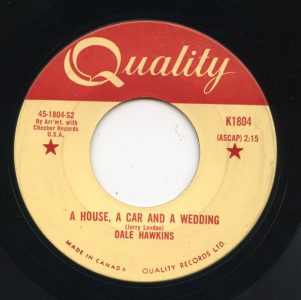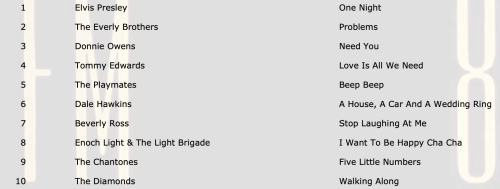#19: A House, A Car And A Wedding Ring by Dale Hawkins
City: London, ON
Radio Station: CKSL
Peak Month: November 1958
Peak Position in London ~ #6
Peak position in Vancouver ~ #46
Peak Position on Billboard Hot 100 ~ #88
YouTube: “A House, A Car, And A Wedding Ring”
Lyrics: “A House, A Car, And A Wedding Ring”
Delmar Allen “Dale” Hawkins was born in Goldmine Plantation, Louisiana, in 1936. Fellow rockabilly singer, Ronnie Hawkins, was his cousin. His family was poor and he picked cotton with Black-Americans to get by. He left home when he was fifteen and joined the United States Navy. After he left the Navy in 1953, he got a job in Shreveport (LA) working for Stanley Lewis at Stan’s Record Shop. He began recording in 1956 and released “See You Soon Baboon”, which opened with a Tarzan call. In 1957, Hawkins was playing at Shreveport clubs. His music was influenced by the new rock and roll style of Elvis Presley and the guitar sounds of Scotty Moore. Still, Hawkins blended that sound with the uniquely heavy blues sound of black Louisiana artists for his recording of his swamp-rock classic, “Susie Q”. He took five months to write the song before August 1954. In early 1957, Hawkins recorded the song late one night at KWKH-AM in Shreveport. The recording was sold to Chess Records which released it as a single in May ’57. “Susie Q” peaked at #7 on the Billboard Rhythm and Blues chart. It reached #27 on the Billboard pop chart in July ’57. In Canada, “Susie Q” reached #6 in Toronto and #10 in Winnipeg.
The liner notes by WLAC-AM Nashville DJ Bill “Hoss” Allen for the 1958 album Oh! Suzy-Q state:
Dale Hawkins says he doesn’t remember when he wasn’t singing. His fans hope he never stops. Born in the bayou country of Louisiana, Dale got his first musical inspiration from the spirituals of the negro field hands. “I picked cotton with them,” says Dale. “And when we took off for dinner, they would teach me the songs and how to play guitar.” This was when he was still in short pants, and Dale has retained the driving, pulsating beat of the southern spiritual to this day. When he was eleven years old Dale bought his first guitar for $11.00. This large amount of coin was saved from selling… newspapers, and young Mr. Hawkins was on his way. Although his first professional job was Shreveport’s radio station KWKH, largely known for its country show “Louisiana Hayride,” Dale says he never would have been a country singer. …I got to have the beat,” he adds. The advent of Rock-A-Billy, or the country version of Rhythm and Blues, was all the musical fame Dale needed to shoot to the top. His “See You Baboon” started the ball rolling, and “Susie Q” was a nation-wide hit. At 19 years of age, this is Dale’s first album. His inimitable driving style, the off-beat sound of the drummer’s cow-bell… make Dale Hawkins an artist to watch in the coming years.
In September 1958, Hawkins released “La-Do-Dada”. The single stalled at #32 in the USA, but climbed to #7 in Toronto and #12 in Winnipeg. Shortly after, Dale Hawkins released “A House, A Car And A Wedding Ring”.

“A House, A Car And A Wedding Ring” was written by Jerry Lordan. He was born in 1934 in London. After high school, Lordan served in the Royal Air Force as a radar operator. He began writing pop songs in 1958. The following year, Lordan wrote “I’ve Waited So Long” which was recorded by Anthony Newley. The single climbed to #3 in the UK that spring. Lordan wrote and recorded three singles in 1960. The most successful was “Who Could Be Bluer?” which peaked at #16 on the UK pop charts. In 1960, Jerry Lordan composed an instrumental titled “Apache”. It was recorded by The Shadows and became a number-one hit in the UK in August and September ’60 for five weeks. Norwegian recording artist Jorgen Ingmann recorded “Apache” and had a #2 hit with the instrumental in the USA in 1961. Later in 1961, Cliff Richard & The Shadows had a #3 UK hit with “A Girl Like You”.
In 1962, Lordan’s “Wonderful Land” was a #2 hit instrumental for The Shadows in the UK. In 1963, Jerry Lordan wrote “Diamonds” which was a number-one instrumental hit for Jet Harris & Tony Meehan in Ireland and the UK. It also peaked at #2 in New Zealand and #3 in Norway. A subsequent instrumental hit written by Jerry Lordan, “Scarlett O’Hara”, was a Top Ten hit in Ireland, Israel, New Zealand and the UK. One final #2 hit instrumental written by Lordan was “Atlantis” by The Shadows. Jerry Lordan wrote one more Top Ten hit which was for Cilla Black in 1969 titled “Conversations”. In 1977, Jerry Lordan appeared in a software pornographic sex comedy titled Come Play With Me. He died in 1995 at the age of 61.
In “A House, A Car and a Wedding Ring”, there is a guy who has three things: 1) a (dream) house (which he built), 2) a (sports coupe) car, and 3) a (golden) wedding ring. However, he doesn’t have “a wife.” He’s made these purchases as he knows a guy can’t keep “roving around.” In addition, he’s got 4) a table, 5) a four-post bed, and 6) a garden where the air smells sweet. Without a wife, he observes “time grows short, and the nights grow long, and it’s a mighty peculiar life.” He hopes there will be a “gal” who is “pretty… warm and sweet” to bring some love into his life (who he can love in return).
“A House, A Car And A Wedding Ring” peaked at #6 in London (ON), #7 in Tyler (TX), #9 in Arlington (VA) and Pine City (MN), #11 in Boston, #14 in Winnipeg, and #16 in Buffalo.
In the late 50s, Dale moved to Philadelphia and was host of WCAU-TV’s The Dale Hawkins Show. By 1961, Dale Hawkins had released 17 singles. His last release that got any regional attention was a cover of a 1945 Guy Lombardo tune titled “Poor Little Rhode Island”. Hawkins also covered Little Walter’s number-one 1955 R&B hit”My Babe”, and Clyde McPhatter and the Drifter’s 1953 R&B smash hit “Money Honey”. But both of these commendable efforts were passed over by most DJs caught up in the Twist dance craze. He switched over to Atlantic Records to release “Stay At Home Lulu” which failed to catch on.
In 1964, Dale Hawkins began to work as a record producer. Among the acts he produced were the Five Americans hit singles “I See The Light”, “Western Union”, Sound of Love” and “Zip Code”; Jon & Robin’s “Do It Again Just A Little Bit Slower”, and John Fred & His Playboy Band (before their big hit “Judy In Disguise (With Glasses)”). In 1969, Hawkins released an album titled L.A., Memphis & Tyler, Texas. A blues-infused instrumental single from the album, “Back Street”, gained airplay in only a few radio markets.
In the mid-60s, Dale Hawkins sold his share of the rights to “Susie Q” for $200. This was a few years before Creedence Clearwater Revival covered the song in 1968 taking “Susie Q” to #10 on the Billboard Hot 100. Had Hawkins kept his ownership of rights to the song, he would have had a steady stream of royalties from CCR’s cover. But it was not to be. Dale Hawkin’s “Susie Q” has appeared in the 1979 film Apocalypse Now, the 1995 Nicole Kidman and Joaquin Phoenix satirical black comedy To Die For, the 2000 science fiction thriller Frequency, and the Argentinian film also from 2000 titled Burnt Money (Plata quemada).
Into the 1970s, Hawkins became addicted to the stimulant Benzedrine. In the early ’80s, he booked himself into rehab to kick the habit. The Arkansas Times reported that “An aptitude test administered in rehab suggested he might have a talent for motivational speaking, and for a couple of years he gave seminars for businessmen at insurance companies. He started Little Rock’s first crisis center, with a suicide hotline for teenagers. In 1986, Dale received an envelope in the mail from MCA, which had bought the entire catalog of Chess Records. envelope held his share of this transaction, a check for sixty-four thousand dollars, after which he began to entertain thoughts of putting together his own studio and making music again.”
Over the decades, Dale Hawkins shared the stage with Clarence “Frogman” Henry, Ray Sharpe, Barbara Lewis, the Cleftones, the Crickets, Roy Head, Jimmy Gilmer, Rocky Brunette, Wanda Jackson, Marvin Rainwater and others.
In 1997, Dale Hawkins performed in concert in Finland. In 1999, Dale Hawkins released new material on his album Wildcat Tamer. In 2005, Dale Hawkins was diagnosed with colon cancer. In 2006, he released his final studio album titled Back Down to Louisiana. In October 2007, The Louisiana Music Hall of Fame honored Dale Hawkins for his contributions to Louisiana music by inducting him into The Louisiana Music Hall Of Fame. In 2010, Hawkins died from cancer at the age of 73.
February 21, 2025
Ray McGinnis
References:
Lindsay Millar, “Rock Candy: Dale Hawkins Dies,” Arkansas Times, Little Rock (AK), February 2010.
“Dale Hawkins,” Oxford American, September 13, 2012.
Bill “Hoss” Allen, “Liner notes,” Oh! Suzy-Q, Chess Records, 1958.
Joe Marchese, “In The Shadow of The Shadows: Songwriter Jerry Lordan Remembered on “All My Own Work“,” The Second Disc, October 16, 2012.
Dale Hawkins, “Susie Q“, American Bandstand, August 6, 1957.
Dale Hawkins, “See You Soon Baboon“, Chess Records, 1956.

CKSL 1410-AM London (ON) Top Ten | November 29, 1958

Leave a Reply